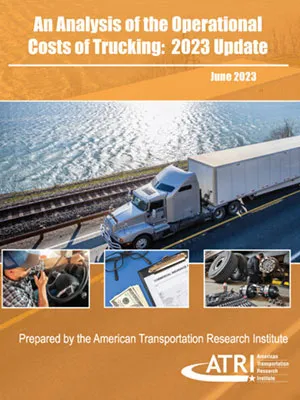Senior Reporter
ATRI: Cost of Operating a Truck Soared in 2022

[Stay on top of transportation news: Get TTNews in your inbox.]
Rising wages for drivers, and the increasing price of insurance, diesel fuels, maintenance costs and other factors, pushed up the cost of operating a truck by 21.3% in 2022, when measured against the same time a year ago.
This is according to the annual American Transportation Research Institute report, “An Analysis of the Operational Costs of Trucking.”
The price of operating a truck rose to $2.251 per mile — the highest level on record — according to the study released June 21.
2022’s rising cost of fuel was the largest driver of the increase and 53.7% higher than in 2021. Other line items also increased by double digits. Driver wages jumped 15.5% to 72.4 cents per mile, reflecting the industry effort to attract and retain drivers. Hundreds of companies raised driver pay, sometimes multiple times during the year to remain competitive.

Driver benefits, however, remained stable in 2022.
ATRI Senior Vice President Dan Murray said the rising operational costs in 2022 were a perfect storm as the COVID-19 pandemic’s impact remained and other international factors contributed to the report’s conclusions.
“This was clearly a gargantuan leap. 2021 was expensive, but the 2022 data exceeded anything we would have guessed if we speculated with world inflation at 6-, 7-, 8-plus percent,” he said. “There was just not one thing you could put your finger on a cause. You wouldn’t have enough fingers.”
ATRI said the cost per hour of operating a truck in 2022 soared by 21.7% compared with 2021 and totaled $90.78 per hour, the highest in the Ops Cost history. The hourly price-per-hour figure increased at a slightly higher rate than the cost per mile because, ATRI said, average truck speed in 2022 increased marginally when measured against 2021.

Murray
“The trucking industry entered a weaker economy in 2022. GDP declined as inflation soared during the first two quarters of 2022, and trucking rates fell throughout the year,” ATRI wrote in the report. “Federal and industry sources reported rising costs in key areas. Fuel costs started spiking after Russia invaded Ukraine in February 2022. Truck purchase prices remained high even while availability improved, as did repair and maintenance costs. Though some costs like auto liability insurance premiums stabilized, others — like driver wages — continued to rise.”
ATRI said 2022’s atypical market conditions also were responsible for unique challenges for acquiring and maintaining equipment.
Truck and trailer payments increased 18.6% to 33.1 cents per mile as carriers paid higher prices, largely due to equipment impediments in the supply chains. Closely related, parts shortages and rising technician labor rates pushed repair and maintenance costs up 12% to 19.6 cents per mile.

Broering
“In a softening market with costs rising at an unparalleled pace, carrier benchmarking becomes more critical than ever,” NFI Integrated Logistics President Dave Broering said. “ATRI’s newest operational costs report provides the reliable data and analysis we need to better understand our partners’ underlying costs in a volatile economy and decelerating rate marketplace.”
NFI ranks No. 16 on the Transport Topics Top 100 list of the largest for-hire carriers in North America.
ATRI’s report said as costs increased during 2022, motor carriers sought to improve their operational efficiency, stabilizing driver turnover rates, reducing detention times and improving equipment utilization across nearly every fleet size and sector during the year. ATRI’s report includes new metrics such as mileage between breakdowns and the ratio of truck drivers to nondriving employees.

Hayden Cardiff, co-founder and chief innovation officer of Idelic, discusses predictive analytics software and scoring driver practices. Tune in above or by going to RoadSigns.ttnews.com.
Murray said even with the double-digit increases in 2022, fleets increased their prices and did improve their overall operations to keep costs manageable and turn a profit.
“If you mine the data, and that’s the power of this report, way beyond the trend lines, profit margins in 2022 stayed reasonably strong, 6% to 8% across most fleet sizes,” he said. “At least in 2022, while costs were going way up, it looks like pricing offset the cost increases.
“We dodged a bullet in 2022 in terms of cost increases by maintaining profitability and strong pricing. But in 2023, the early indications are we’re going to see prices dropping significantly but the costs remaining high, with the exception of fuel.”
According to the Energy Information Administration, the national average price for a gallon of diesel on June 19 was $3.815 a gallon, a drop of nearly $2 a gallon from the same period a year ago.
The ATRI report also said that in 2022 the average truck was driven 78,863 miles, compared with 79,808 in 2021. ATRI said the approximately 1,000-mile decline can be associated with growing congestion and changing business models in the trucking industry, including efforts to get drivers home more frequently.
Alternative-fueled vehicles also are becoming more popular in the trucking industry. ATRI said in 2022, 8.2% of respondent fleets included at least one Class 8 truck-tractor powered by an alternative fuel source, up from 7% in 2021.
Compressed natural gas trucks were the most popular at 6.2%. Battery-electric trucks are 5.1%, liquefied natural gas vehicles are 2.1%, liquefied petroleum gas at 0.5% and hydrogen fuel cell vehicles, which are still under development, at 0%.
Want more news? Listen to today's daily briefing below or go here for more info:




